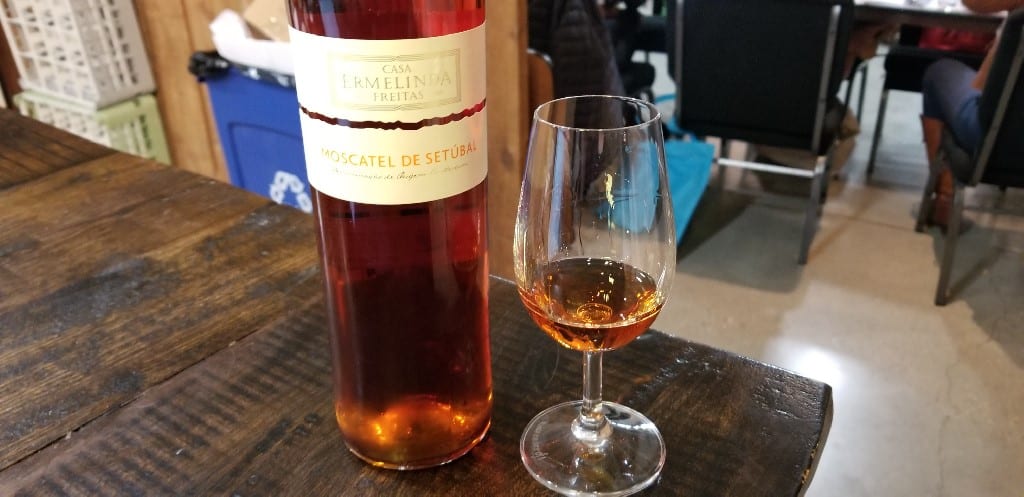

06 Nov Setúbal – an old region is new to the U.S.
Living in the United States, we are exposed to many wines from around the world: France, Italy, Australia, New Zealand and Spain, to name a few countries. But, what about Portugal? I am familiar with the fortified wines of Madeira and Porto and have tasted some still wines from Alentejo and Dao. But when I was asked to organize some intimate events for the region of Setúbal, my curiosity was piqued.


The first challenge was saying Setúbal properly. After some practice with the Portuguese speakers, I was finally able to properly say it – “StUbal”. Remove the first “e” and stress the “u” and you, too, can sound like you speak Portuguese.
One unique thing about the vineyards in Setúbal is that the vines are planted on north-facing slopes.
It is possible, yet not probable, that you have heard of Moscatel de Setúbal. Moscatel de Setúbal is the traditional wine of D.O Setúbal. Produced in a specific geographical region demarcated by the municipalities of Montijo, Palmelo, Setúbal and the Castelo parish, D.O. Setúbal is a fortified wine that must be at least 85 percent Moscatel (Muscat). The grape skins are left in during fermentation and grape brandy is added when the wine has fermented to the required level of sweetness. The wine spends an additional three months on the skins and is then transferred to large wooden vats for a minimum of 18 months. The resulting wine has notes that range from flowers and marmalade to figs and nuts.


D.O. Setúbal was established in 1907 but the region is home to a variety of quality dry, non-fortified wines as well. There are more than 200 grapes grown in Setúbal and the majority of them are indigenous. Some of the grapes grown include Antão Vaz, Arinto, Siria (Roupeiro), Verdelho, Viosinho, Fernão Pires (Maria Gomes), Aragonês, Castelão (Periquita), Touriga Nacional and Tricaderia. These wines are part of D.O. Palmela, which was established in 1989. D.O. Palmela covers the same area as the D.O. Setúbal.
Filipe Palhoça São Filipe Branco 2017, Peninsula de Setúbal PGI (12.5 percent alcohol) – A blend of Fernão Pires, Arinto and Siria, the wine has beautiful, fresh aromatics. Citrus, stone fruits and melon jump out of the glass. The wine has crisp acidity and a refreshing finish.
Bacalhôa Catarina Branco 2017, Peninsual de Setúbal PGI (14 percent alcohol) – A blend of Fernão Pires, Chardonnay and Arinto, the grapes, grown in clay-limestone soils, are fermented separately, and the Chardonnay is fermented and aged in French Oak. Delicate aromas of stone fruit and vanilla hit the nose, and on the palate, the wine is vibrant with elegant acidity.
Fernão Po Adega Winery ASF Rosé, D.O. Palmela (12.5 percent alcohol) – With just a touch of residual sugar, this lovely elegant candy-pink rosé is made from 100 percent touriga nacional. Grown in sandy soils, the resulting wine is bright, fruity and delicate.
Adega de Pegôes Alto Pina Reserva Tinto 2016, Peninsula de Setúbal PGI (14 percent alcohol) –Castelão, Aragonês and Touriga Nacional are blended and matured in French and American oak for six months. Red and black fruit notes dominate the nose and continue through onto the palate with a touch of grape jolly rancher. The wine has grippy tannins that hit the center of the palate.
Adega de Palmela Tinto Reserva 2013, Palmela PDO (14.5 percent alcohol) – A blend of Castelão, Syrah, Aragonês, Cabernet Sauvignon, the wine spends eight months in French and American oak and has hints of leather, cherry and toast. There is high acid on the finish, as well as smooth tannins.
Casa Ermelinda Freitas Moscatel de Setúbal, D.O. Setúbal (17.5 percent alcohol) – Produced from 20-year-old vines, the wine goes through stainless steel fermentation and a long maceration period, followed by 24 months in oak and then aged for 20 more years. The wine is a light brown color with aromas of apricot skins and orange blossoms. With 150 grams of sugar, the sweetness is balanced with intense acidity and the finish goes on and on and on.
Delving into the new wine region of Setúbal is intriguing and eye-opening. There are so many exquisite indigenous grapes around the world and so many interesting, well-made, food-friendly wines to explore.
Read the original story in the Napa Valley Register.Discover more from Please The Palate
Subscribe to get the latest posts sent to your email.



